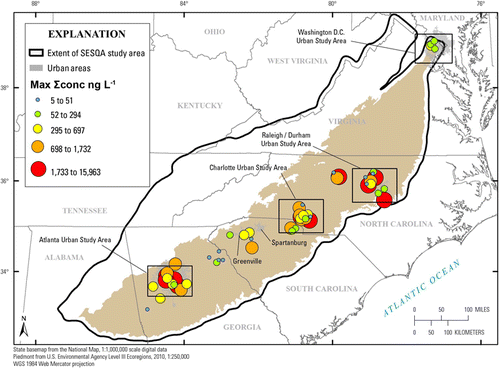Pharmaceuticals in streams may come from multiple sources

Pharmaceuticals in surface water such as lakes and streams are a growing concern. They can cause developmental and other health issues in aquatic life. Scientists have largely considered treated wastewater that's released into the environment as the main source. But now one team reveals in ACS' journal Environmental Science & Technology Letters that other important factors are also contributing to the problem.
One specific diabetes drug, metformin, has been found widely in treated wastewater, in naturally occurring water bodies and even in tap water. Some research has shown that the drug can cause genetic changes in fish. Similar studies have found that other pharmaceuticals can also have various health effects on aquatic life. While treated wastewater that is introduced back into the environment is an obvious route for drugs to enter waterways, Paul M. Bradley and colleagues wanted to see whether other sources might be involved.
The researchers tested water from 59 streams across four states in the Southeastern U.S., both close to and far away from wastewater treatment plants. The samples contained a wide range of pharmaceuticals and other active compounds, including metformin, nicotine and the anti-seizure medication carbamazepine, at varying concentrations. Their results confirmed that wastewater plants are important sources of pharmaceuticals, but they also demonstrated that these compounds are common in streams that aren't fed by wastewater plants. This suggests that urban run-off and the below-surface movement of water could be important contributors to the flow of drugs into streams.
More information: Paul M. Bradley et al. Metformin and Other Pharmaceuticals Widespread in Wadeable Streams of the Southeastern United States, Environmental Science & Technology Letters (2016). DOI: 10.1021/acs.estlett.6b00170
Abstract
Pharmaceutical contaminants are growing aquatic-health concerns and largely attributed to wastewater treatment facility (WWTF) discharges. Five biweekly water samples from 59 small Piedmont (United States) streams were analyzed for 108 pharmaceuticals and degradates using high-performance liquid chromatography and tandem mass spectrometry. The antidiabetic metformin was detected in 89% of samples and at 97% of sites. At least one pharmaceutical was detected at every site (median of 6, maximum of 45), and several were detected at ≥10% of sites at concentrations reported to affect multiple aquatic end points. Maximal cumulative (all detected compounds) concentrations per site ranged from 17 to 16000 ng L–1. Watershed urbanization, water table depth, soil thickness, and WWTF metrics correlated significantly with in-stream pharmaceutical contamination. Comparable pharmaceutical concentrations and detections at sites with and without permitted wastewater discharges demonstrate the importance of non-WWTF sources and the need for broad-scale mitigation. The results highlight a fundamental biochemical link between global human-health crises like diabetes and aquatic ecosystem health.
Journal information: Environmental Science & Technology Letters
Provided by American Chemical Society

















